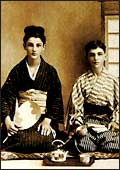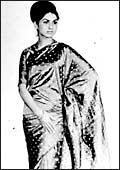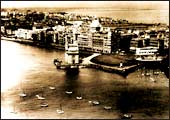 |
| The Gateway of India, built over 20 years
after the completion of the Taj Mahal Hotel (seen in background) |
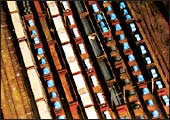 |
| Railway wagons in Jamshedpur carrying various
products of Tata Steel |
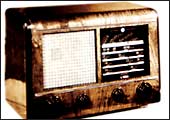 |
| An early Nelco radio set. The National Radio
and Electronics Company Limited was established in 1940 |
It is unlikely
that too many people in this country have read Two Young Men Who
Went West, the opening piece (it is as large as a novella) in
Tom Wolfe's Hooking Up, that writer's take on the information
age. This writer read it only because he happens to be a Wolfe-junkie
(cured since by I am Charlotte Simmons, but that's another story).
At one level, Two Young Men... is the story of the birth of Silicon
Valley; at another, it is the history of the early years of Intel;
and at still another, it is about the birth of the New Economy.
Horizons, The Tata India Century 1904-2004, the book this piece
is about, released more than a month ago by India's Finance Minister
P. Chidambaram at the "mother of all book-launches"
as an editor of this magazine present on the occasion reported,
could have been all that-the history of the Tata empire, the story
of modern India, a tale of enterprise, a fascinating (and still-emerging)
tableau of men-at-work involving such worthy protagonists as Jamsetji
Nusserwanji Tata, Homi Baba, J.R.D. Tata, Ratan Tata, Faqir Chand
Kohli-and more. It isn't, but more on that later.
|
|
HORIZONS
THE TATA-INDIA CENTURY 1904-2004
By Aman Nath & Jay Vithalani with Tulsi Vatsal
India Book House
PP: 358
Price: Rs 3,000
|
Authors Aman Nath (responsible for concept
and design according to the credits), Jay Vithalani and Tulsi
Vatsal (text research) deserve credit for producing a coffee-table
tome that is rich in facts, features photographs, many of them
never seen before, and captures a century through the simple device
of presenting the year in question from the perspective of India
and that of the Tata Group on facing pages. And the Tata Group
deserves credit for, well, possessing, through the 100 years the
book covers, the prescience to know that it was creating history.
Few business houses in India and elsewhere attach much importance
to history; the Tata Group's approach is manifest in photographs
and documents from the archives scattered across the book (a sampling:
the original drawing, circa 1903 of the dome of the Taj Mahal
Hotel, Mumbai; Homi Bhaba's letter to J.R.D. Tata, circa 1943,
which led to the founding of the Tata Institute of Fundamental
Research; a cartoon by Bal Thackeray that appeared in The Free
Press Journal, circa 1952, 'showing Naval Tata fighting unpleasant
smells with a bottle of perfume', to mark the creation of TOMCO).
Where the authors have erred, in this writer's
opinion, is in excluding drama from the 100 years the book covers,
although this could have been at the insistence of the Tata Group
(the copyrights to the text and photographs are held by Tata Sons,
according to the credits), which has always sought to portray
a controversy-free image. The best histories (even corporate)
are those that are told as stories and there are times, when flipping
through this impressive book, that terms such as sanitised and
corporate brochure come to mind. Horizons is, in its present form,
impressive; as a story, it may have just been a bit better.
|
|
|
|
| Robert C. Sahlin, son of Axel Sahlin, seated at the table
with other covenanted officers at the opening of a new machine
shed (Tata Steel) |
Jeh (JRD), aged 13, and sister Sylla in Japanese costume |
Parmeshwar Mader (now Godrej) in the new sari uniform of
Air India |
|









